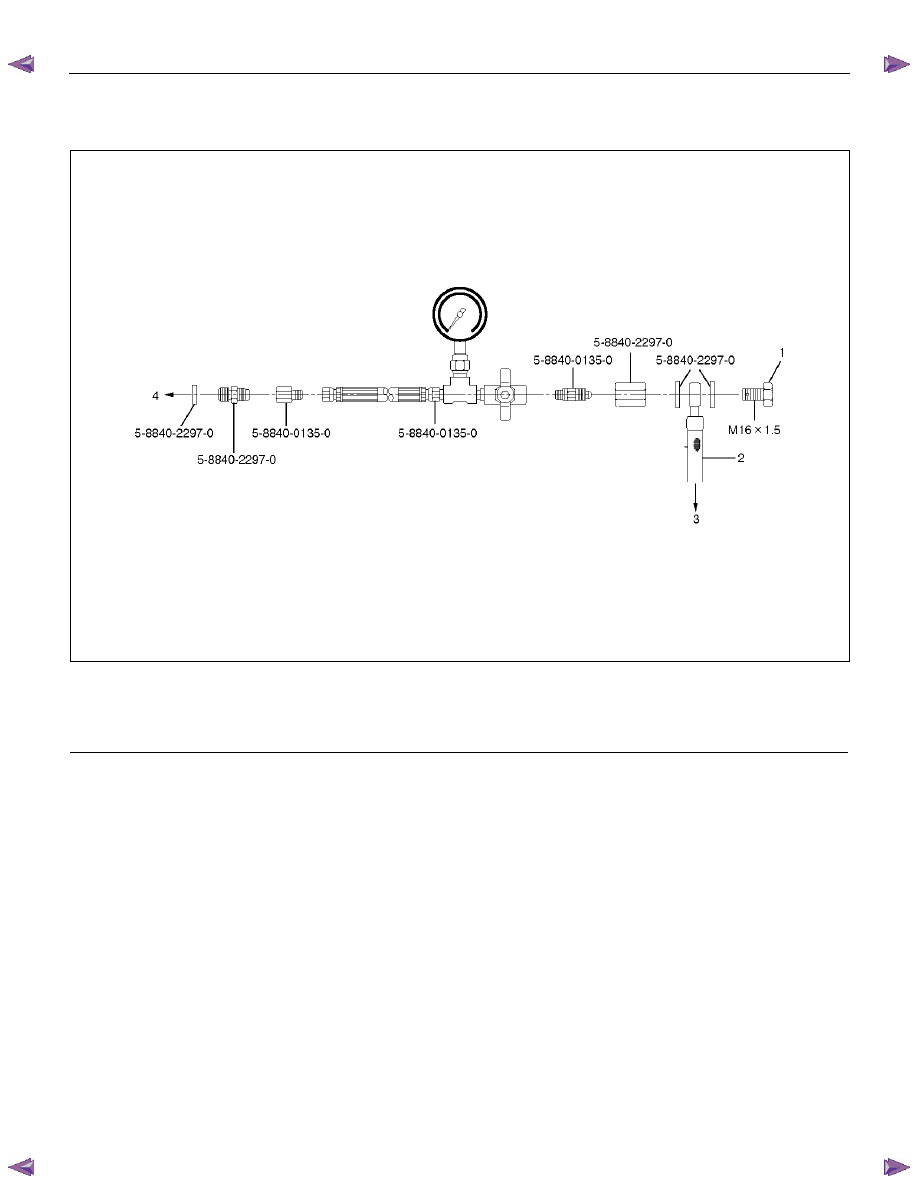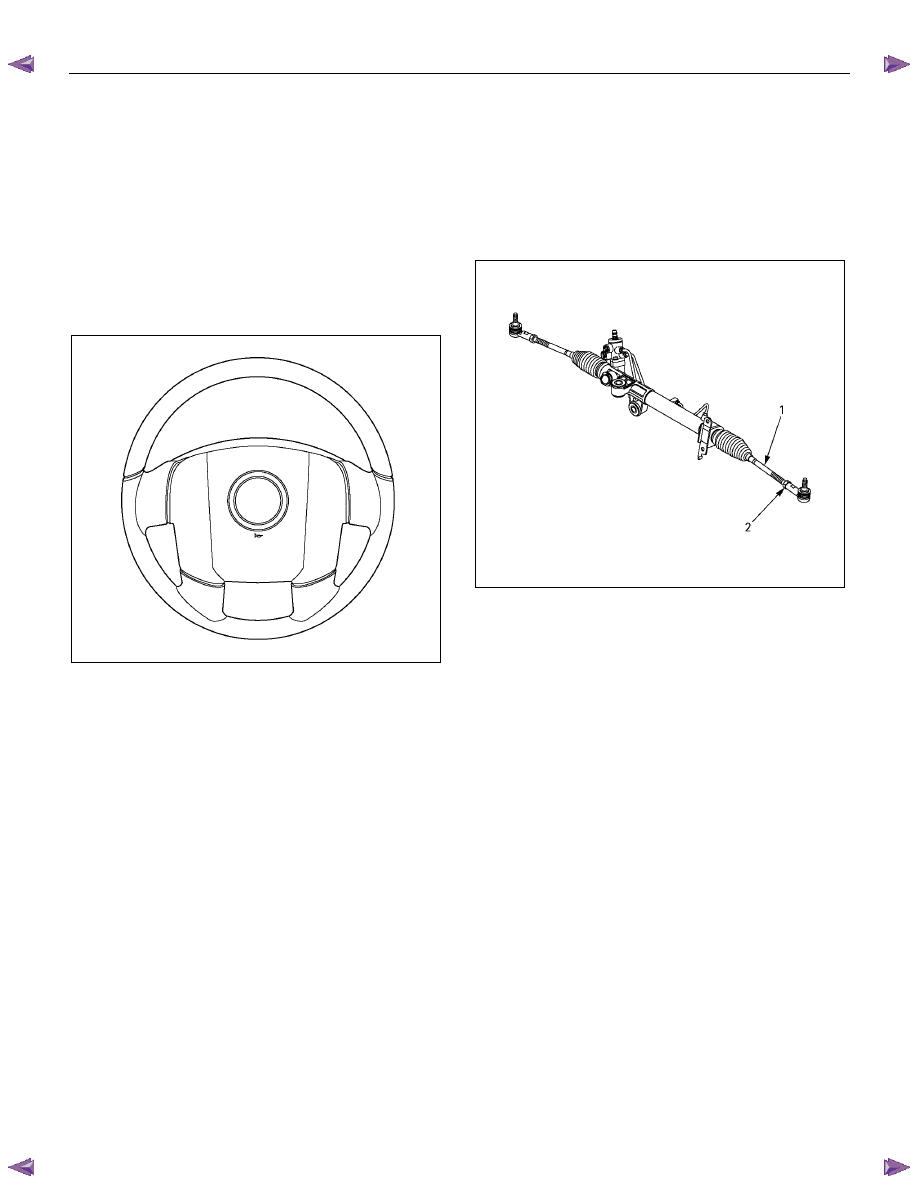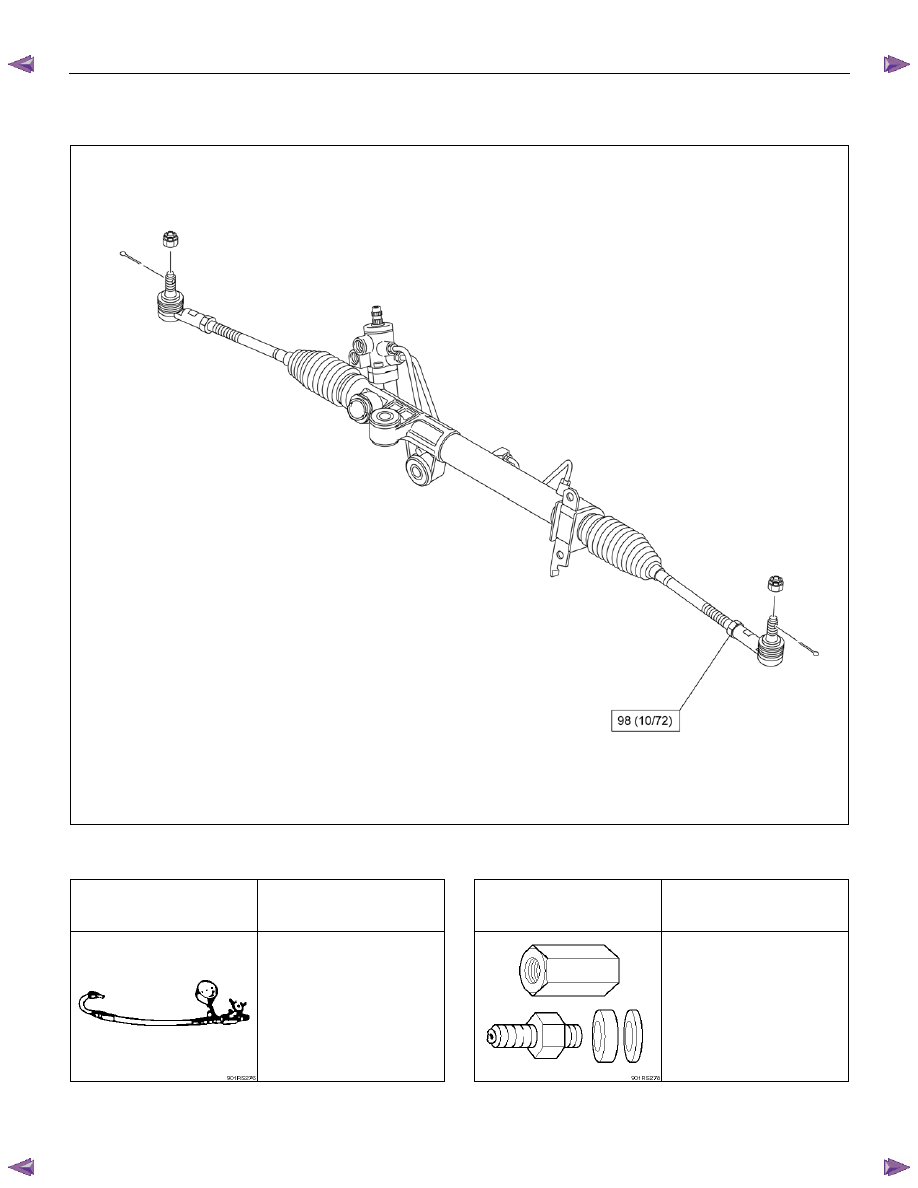Isuzu KB P190. Manual — part 67

POWER-ASSISTED STEERING SYSTEM 3B-7
Power Steering System Test
Test Procedure
F02RX002
Legend
(1) Bolt
(2) Hose
(3) Power Steering Unit
(4) Power Steering Pump
The fluid pressure test in the power steering system is
performed to determine whether or not the oil pump and
power steering unit are functioning normally.
The power steering system test is used to identify and
isolate hydraulic circuit difficulties. Prior to performing
this test, the following inspections and corrections, if
necessary, must be made.
・ Inspect pump reservoir for proper fluid level.
・ Inspect pump driver gear condition.
1. Place a container under the pump to catch the fluid
when disconnecting or connecting the hoses.
2. With the engine NOT running, disconnect the
pressure hose at the power steering pump and
install power steering tester 5-8840-0135-0 and
power steering tester adapter 5-8840-2297-0 as
shown in the illustration. The gage must be between
the shutoff valve and pump. Open the shutoff valve.
3. Check the fluid level. Fill the reservoir with power
steering fluid, to the "Full" mark. Start the engine,
then turn the steering wheel and momentarily hold it
against a stop (right or left). Turn the engine off and
check the connections at tester for leakage.
4. Bleed the system. Refer to Bleeding the Power
Steering System in this section.
5. Start the engine and check the fluid level. Add
power steering fluid if required. When the engine is
at normal operating temperature, increase engine
speed to 1500 rpm.
CAUTION: Do not leave shutoff valve fully closed
for more than 5 seconds, as the pump could
become damaged internally.
3B-8 POWER-ASSISTED STEERING SYSTEM
6. Fully close the shutoff valve. Record the highest
pressures.
・ If the pressure recorded is within 9800-10300 kPa
(100-105 kg/cm
2
/1422-1493psi), the pump is
functioning within its specifications.
・ If the pressure recorded is higher than 10300 kPa
(105 kg/cm
2
/1493psi), the valve in the pump is
defective.
・ If the pressure recorded is lower than 9800 kPa
(100 kg/cm
2
/1422psi), the valve or the rotating
assembly in the pump is defective.
7. If the pump pressures are within specifications,
leave the valve open and turn (or have someone
else turn) the steering wheel fully in both directions.
Record the highest pressures and compare with the
maximum pump pressure recorded in step 6. If this
pressure cannot be built up at either side of the
power steering unit, the power steering unit is
leaking internally and must be replaced.
8. Shut the engine off, remove the testing gauge.
9. Reconnect the pressure hose, check the fluid level
and make the needed repairs.
10. If the problem still exists, the steering and front
suspension must be thoroughly examined.
Maintenance
The hydraulic system should be kept clean, the fluid
level in the reservoir should be checked at regular
intervals and fluid added when required. Refer to
Recommended Fluids and Lubricants in General
Information section for the type of fluid to be used and
the intervals for filling.
If the system contains some dirt, flush it as described in
this section. If it is exceptionally dirty, the pump must be
completely disassembled before further usage. (The
steering unit cannot be disassembled.)
All tubes, hoses, and fittings should be inspected for
leakage at regular intervals. Fittings must be tight. Make
sure the clips, clamps and supporting tubes and hoses
are in place and properly secured.
Power steering hoses and lines must not be twisted,
kinked or tightly bent. Air in the system will cause
spongy action and noisy operation. When a hose is
disconnected or when fluid is lost, for any reason, the
system must be bled after refilling. Refer to Bleeding the
Power Steering System in this section.
・ Inspect gear for looseness or damage.
・ Inspect hoses to insure they are not touching any
other parts of the vehicle.
・ Inspect fluid level and fill to the proper level.
Fluid Level
1. Run the engine until the power steering fluid
reaches normal operating temperature, about 55°
C (130°F), then shut the engine off.
2. Check the level of fluid in the reservoir.
3. If the fluid level is low, add power steering fluid as
specified in General Information to the proper level
and install the receiver cap.
4. When checking the fluid level after the steering
system has been serviced, air must be bled from
the system. Refer to Bleeding the Power Steering
System in this section.
Bleeding the Power Steering System
When a power steering pump or unit has been installed,
or an oil line has been disconnected, the air that has
entered the system must be bled out before the vehicle
is operated. If air is allowed to remain in the power
steering fluid system, noisy and unsatisfactory operation
of the system may result.
Bleeding Procedure
When bleeding the system, and any time fluid is added
to the power steering system, be sure to use only power
steering fluid as specified in General Information.
1. Fill the pump fluid reservoir to the proper level and
let the fluid settle for at least two minutes.
2. Start the engine and let it run for a few seconds. Do
not turn the steering wheel. Then turn the engine
off.
3. Add fluid if necessary.
4. Repeat the above procedure until the fluid level
remains constant after running the engine.
5. Raise and support the front end of the vehicle so
that the wheels are off the ground.
6. Start the engine. Slowly turn the steering wheel right
and left, lightly contacting the wheel stops.
7. Add power steering fluid if necessary.
8. Lower the vehicle, set the steering wheel at the
straight forward position after turning it to its full
steer positions 2 or 3 times, and stop the engine.
9. Check the fluid level and refill as required.
10. If the fluid is extremely foamy, allow the vehicle to
settle for a few minutes, then repeat the above
procedure.
Flushing the Power Steering System
1. Raise and support the front end of the vehicle off
the ground until the wheels are free to turn.
2. Remove the fluid return line at the pump inlet
connector and plug the connector port on the pump.
Direct the line toward a large container to catch the
draining fluid.
3. While running the engine at idle, fill the reservoir
with new power steering fluid. Turn the steering
wheel in both directions. Do not contact or hold the
steering wheel to the wheel stops. This will cause
the pump to go to pressure relief mode, which may
cause a sudden fluid overflow at the reservoir.

POWER-ASSISTED STEERING SYSTEM 3B-9
4. Install all the lines and hoses. Fill the system with
new power steering fluid and bleed the system as
described in Bleeding the Power Steering System.
Operate the engine for about 15 minutes.
Remove the pump return line at the pump inlet and
plug the connection on the pump. While refilling the
reservoir, check the draining fluid for contamination.
If foreign matter is still evident, replace all lines,
disassemble and clean or replace the power
steering system components. Do not re-use any
drained power steering fluid.
Steering Wheel Free Play Inspection
RTW73BSH000901
1. With the tires in the straight-ahead position, check
the amount of steering wheel play by turning the
wheel in both directions until the tires begin to move.
NOTE: The wheel free play should be checked with the
engine running.
Free play: 0 - 30 mm (0 - 1.18 in)
2. Also check the steering wheel for play and
looseness in the mount by moving it back and forth
and sideways. When test driving, check for hard
steering, steering shimmy and tendency to pull to
one side.
Front End Alignment Inspection and
Adjustment
Toe-in Adjustment
Toe-in: Refer to Section 3A FRONT ALIGNMENT
1. To adjust the toe-in angle, loosen the lock nuts (2)
on the tie rod (1) and turn the tie rod. Turn both rods
the same amount, to keep the steering wheel
centered .
431R30006
2. Tighten the lock nut to the specified torque.
Torque:
98 N
⋅⋅⋅⋅m (10 kgf⋅⋅⋅⋅m/72 lb⋅⋅⋅⋅ft)

3B-10 POWER-ASSISTED STEERING SYSTEM
Torque Specification
N
⋅m (kgf⋅m/Ib⋅ft)
RTW53BLF001001
Special Tools
ILLUSTRATION
TOOL NO.
TOOL NAME
ILLUSTRATION
TOOL NO.
TOOL NAME
5-8840-0135-0
(J-29877-A)
Tester;
Power steering
5-8840-2297-0
(J-39213)
Adapter;
Power steering tester

Нет комментариевНе стесняйтесь поделиться с нами вашим ценным мнением.
Текст